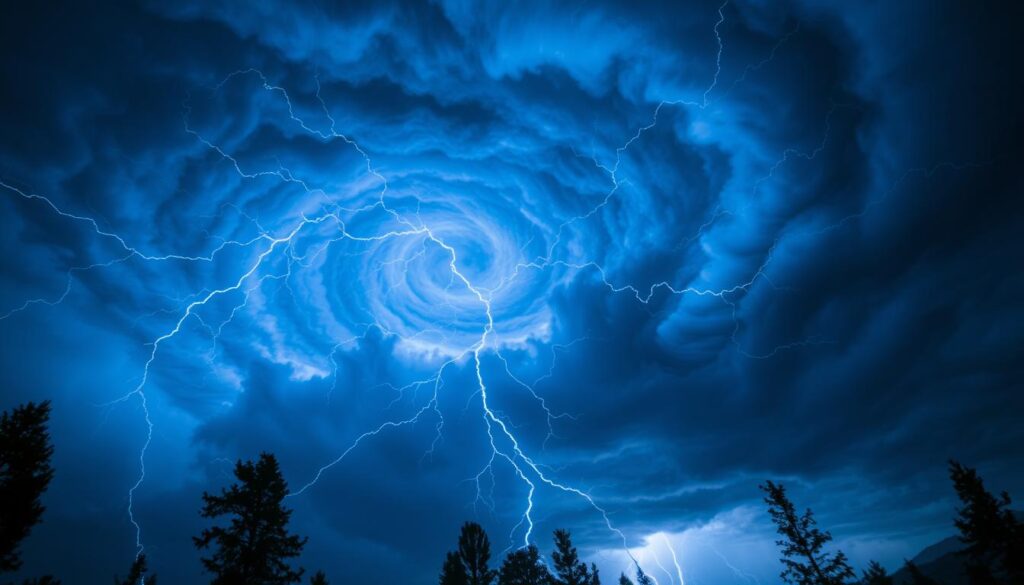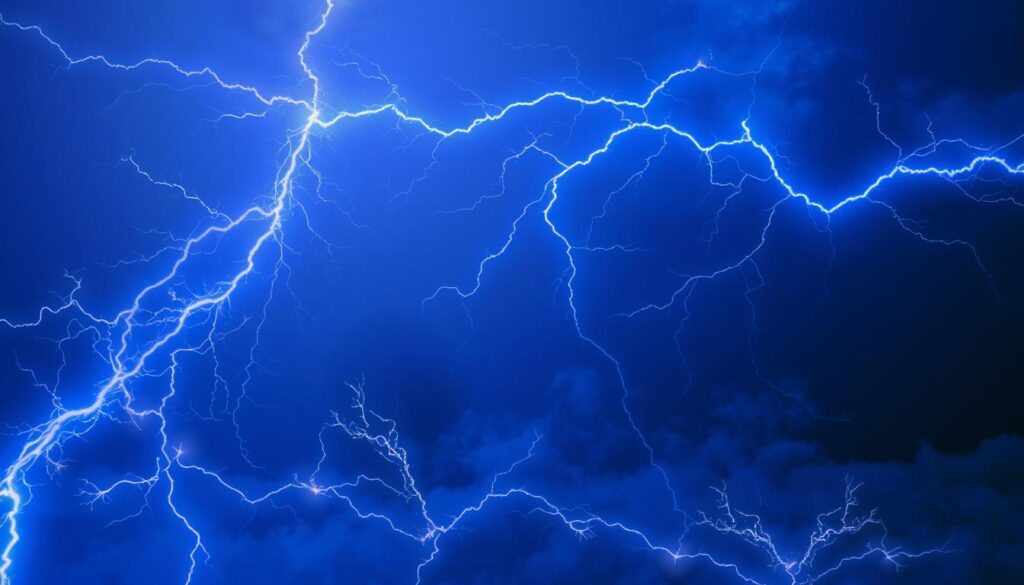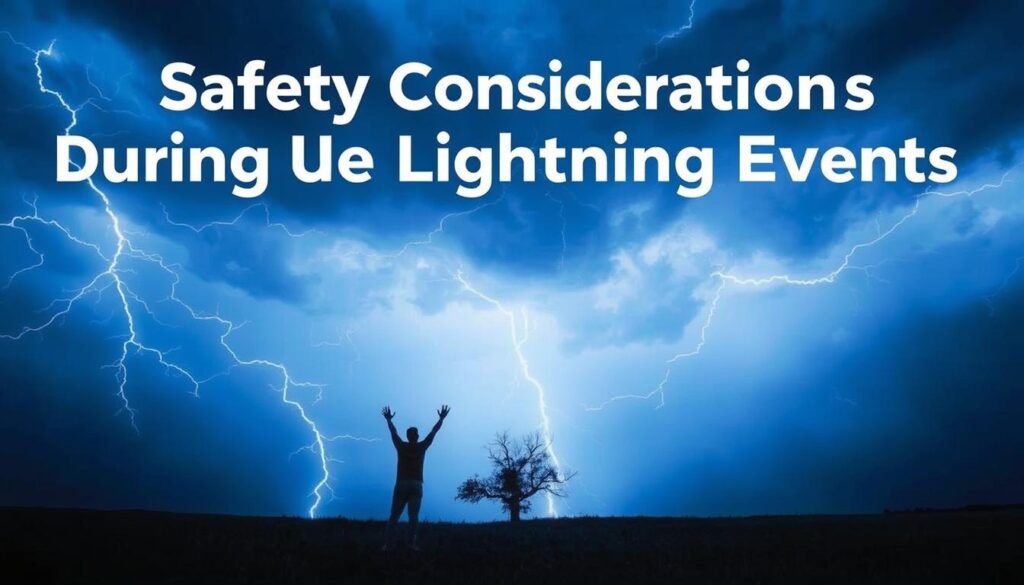Blue Lightning in Storms is a rare and amazing sight that has always caught people’s attention. It’s called blue jets and shows up as a bright blue flash in severe thunderstorms. This phenomenon is a powerful display of storm energy.
The science world is trying to figure out why and how Blue Lightning in Storms happens. It’s a unique way that electricity acts in the atmosphere.

Learning about Blue Lightning in Storms helps us understand how electricity works in storms. By studying it, scientists can learn more about the complex processes in the atmosphere. These processes lead to the creation of Blue Lightning in Storms.
Key Takeaways
- Mysterious Blue Lightning in Storms is a rare display of atmospheric electricity
- It appears as a bright blue flash during severe thunderstorms
- Blue lightning is also known as blue jets
- Scientists are working to understand the causes and characteristics of Blue Lightning in Storms
- Studying blue lightning can provide insights into atmospheric electricity and storm phenomena
What Makes Blue Lightning in Storms Different from Regular Lightning
Blue Lightning in Storms is a rare and fascinating phenomenon. It has caught the eye of scientists and the public. Its unique color, a blue hue, sets it apart from regular lightning.
The color comes from the specific wavelengths of light emitted during a lightning strike. This makes Blue Lightning in Storms stand out.
Blue Lightning in Storms is different from regular lightning in many ways. Its formation, speed, and energy release are unique. The atmospheric conditions that lead to blue lightning are also special. These conditions often include intense thunderstorms and heavy rainfall.
The electrical discharges in Blue Lightning in Storms are more intense and powerful. This makes blue lightning a distinct type of lightning.
Some key characteristics of blue lightning include:
- Unique color spectrum, with a blue hue
- Different formation mechanisms, speed, and energy release compared to regular lightning
- Association with intense thunderstorms and heavy rainfall
- More intense and powerful electrical discharges
Blue Lightning in Storms is a fascinating area of study. Its unique characteristics capture the attention of scientists and researchers. By studying blue lightning, we can learn more about the complex nature of atmospheric conditions and electrical discharges in thunderstorms.
The Science Behind Mysterious Blue Lightning in Storms
Storm research has deepened our understanding of Blue Lightning in Storms. This rare sight has unique electrical properties shaped by its surroundings. The creation of blue lightning is complex, involving temperature and humidity in the atmosphere.
Atmospheric science is key to understanding blue lightning. By studying the electrical properties of storms, researchers uncover its secrets. Blue lightning often appears in intense thunderstorms, where the right conditions and electrical properties come together.
Scientists are actively researching blue lightning. They use advanced tech to learn about its causes and traits. By combining atmospheric science and electrical properties, they aim to fully grasp this mysterious phenomenon.
Several factors help create blue lightning, including:
- Atmospheric conditions, such as temperature and humidity
- Electrical properties of the storm, including charged particles
- The interaction between the storm and its environment, like clouds and rain
Historical Observations and Documentation
Blue lightning has always fascinated people, with cultures documenting it in their own ways. Historical weather events have greatly helped us understand this rare sight. Different cultures see blue lightning as either good luck or a bad sign.
Studying storms has been key to learning about blue lightning. By looking at old records, scientists have found patterns. This knowledge helps us understand the science behind blue lightning.
Many famous blue lightning events have been recorded. These events have helped scientists and had a big impact on communities. For example, the great storm of 1908 in New York City was marked by intense blue lightning. It was seen as a sign of the city’s growth.
In many cultures, blue lightning is seen as spiritually significant. It’s believed to connect us to the divine. By studying history, we can learn more about blue lightning and its cultural importance.
Where and When Blue Lightning in Storms Typically Occurs
Blue lightning is a rare and amazing sight that can happen in many geographical locations worldwide. To figure out where and when it happens, we need to look at weather patterns and storm prediction data. By studying these, researchers find out when and where blue lightning is more likely to appear.
Places with high humidity and unstable air, like tropical and subtropical areas, are more likely to see blue lightning. These conditions create intense thunderstorms, which often bring blue lightning. To predict when blue lightning might happen, scientists use advanced computer models.
Here are some key factors that contribute to the occurrence of blue lightning:
- Instability in the atmosphere
- High levels of humidity
- Presence of ice crystals in clouds
- Intense thunderstorm activity
By understanding these factors and analyzing weather patterns and storm prediction data, researchers can better predict when and where blue lightning is likely to occur. This knowledge helps improve storm prediction models and gives insights into the rare and fascinating phenomenon of blue lightning.
The Role of Atmospheric Conditions
Atmospheric conditions are key in creating blue lightning. The right mix of temperature, pressure, and humidity helps clouds form. This is important for meteorologists to predict blue lightning.
Cloud physics shows that certain clouds, like cumulonimbus, are more likely to have blue lightning. These clouds grow tall when warm, moist air rises. Inside these clouds, ice crystals and supercooled water droplets help create the electrical charges for blue lightning.
- Temperature gradients: Changes in temperature with altitude help clouds form and electrical charges develop.
- Pressure systems: The movement of high and low-pressure systems can shape cloud formation and storm paths.
- Humidity: Moisture in the air is crucial for cloud formation and electrical charge development.
By studying these factors, scientists better understand blue lightning. This knowledge helps improve weather forecasts and warnings. It keeps people safe from severe storms.
Understanding the Electrical Properties
To understand blue lightning, we must look at its electrical properties. Electrical discharges are key in creating blue lightning. Studying plasma and lightning physics helps us understand these discharges.
Blue lightning involves leaders and return strokes. Leaders are ionized air channels for electrical current. Return strokes are quick pulses of electricity that follow the leader. How these parts work together affects blue lightning’s color and intensity.
Research on electrical discharges has revealed much about blue lightning. By studying its electrical properties, scientists learn more about its physics. This knowledge helps us better understand lightning and plasma, preparing us for severe weather.

- High temperatures and pressures that facilitate the formation of plasma
- Electrical discharges that occur at incredibly high speeds
- Complex interactions between leaders and return strokes that influence the characteristics of blue lightning
Exploring blue lightning’s electrical properties helps us understand this mysterious phenomenon. It shows us the complex physics at work in our atmosphere.
Impact on Weather Research and Storm Prediction
Studying blue lightning has greatly helped in weather research and storm prediction. Scientists learn a lot by looking at blue lightning’s unique traits. This helps them understand severe weather better.
This knowledge has led to better detection technology. Now, researchers can track and predict storms more accurately.
Blue lightning research has made a big difference in several areas:
- Storm prediction models are now more accurate. They can handle the complex interactions between the atmosphere and electricity.
- New detection technology like satellite imaging and lightning detection networks give real-time storm data.
- Weather research has also advanced. We now know more about how blue lightning affects severe weather.
As researchers keep studying blue lightning, they find new ways to help with weather research and storm prediction. These discoveries help scientists come up with better ways to predict and deal with severe weather.
Safety Considerations During Blue Lightning Events
During blue lightning events, lightning safety is key. It’s important to take steps to stay safe. Knowing storm precautions and following guidelines can help avoid dangers.
It’s best to avoid open areas and find shelter in sturdy buildings. This is crucial because the risk of being hit by lightning is higher. Having an emergency response plan is also vital. It should tell you what to do if lightning strikes.

- Staying away from windows and doors
- Avoiding contact with conductive objects
- Unplugging electronics and appliances
- Having a first aid kit on hand
By following these tips, you can lower your risk of injury during blue lightning events. It’s also crucial to have an emergency response plan. This plan should cover evacuation, first aid, and getting medical help if needed.
Photography and Documentation Techniques
Storm photography is a mix of technical skills and safety. It’s important to know the risks and take steps to stay safe. This means being aware of your surroundings and keeping a safe distance from the storm. Using protective gear like a lightning rod or Faraday cage is also crucial.
Photographers use special equipment like high-speed cameras and tripods to capture blue lightning. To get stunning photos, use a wide-angle lens and shoot in RAW format. Taking multiple shots quickly can help you get the perfect image. By following these tips and focusing on safety, you can take amazing photos of blue lightning.
Some key considerations for storm photography include:
- Using a camera with good low-light performance to capture the faint glow of blue lightning
- Shooting from a safe location, such as a vehicle or a building with a lightning rod
- Being aware of changing weather conditions and seeking shelter if necessary
Storm photographers combine technical skills with respect for nature’s power. This creates stunning images that inspire and educate. Whether you’re experienced or new, capturing a blue lightning strike is thrilling. It requires patience, skill, and a commitment to safety.
Conclusion: The Continuing Mystery of Nature’s Blue Light Show
Exploring mysterious phenomena like blue lightning shows us there’s still a lot to learn. Our knowledge of this natural wonder has grown, thanks to research. Yet, the mystery keeps drawing in scientists and fans.
Blue lightning’s unique color and electrical properties remind us of nature’s power and complexity. By studying it, we gain new insights. These insights not only help us understand the atmosphere better but also make us appreciate nature’s beauty more.
The quest to understand blue lightning is ongoing, with many discoveries yet to be made. Each new finding brings us closer to knowing this natural wonder better. This journey shows the never-ending curiosity of humans.
FAQ
What makes blue lightning different from regular lightning?
Blue lightning, or “blue jets,” is a bright blue flash seen in severe thunderstorms. It’s different from the usual white or yellow lightning. The blue color comes from the specific wavelengths of light during the electrical discharge.
Where and when is blue lightning typically observed?
Blue lightning often happens in areas with certain weather patterns. This includes places with supercell thunderstorms or tropical cyclones. These storms usually form at specific times, based on the local climate and geography.
What are the scientific properties of blue lightning?
Blue lightning has unique scientific properties compared to regular lightning. These include how it forms, its speed, and energy release. Scientists are still studying the electrical properties and atmospheric conditions needed for blue lightning.
How can I safely observe and document blue lightning?
To safely watch or take pictures of blue lightning, always put safety first. Stay away from open areas and find shelter in strong buildings. Follow emergency response rules. Using the right equipment and techniques can help you capture this amazing natural event.
How does the study of blue lightning contribute to weather research and storm prediction?
Studying blue lightning helps us understand atmospheric science better. It also improves storm forecasting. New detection methods and research in this area have made storm predictions more accurate and timely.
Source
https://en.wikipedia.org/wiki/St._Elmo%27s_fire?utm
https://weather.com/safety/thunderstorms/news/2024-04-30-bolt-from-the-blue-lightning-thunderstorms
